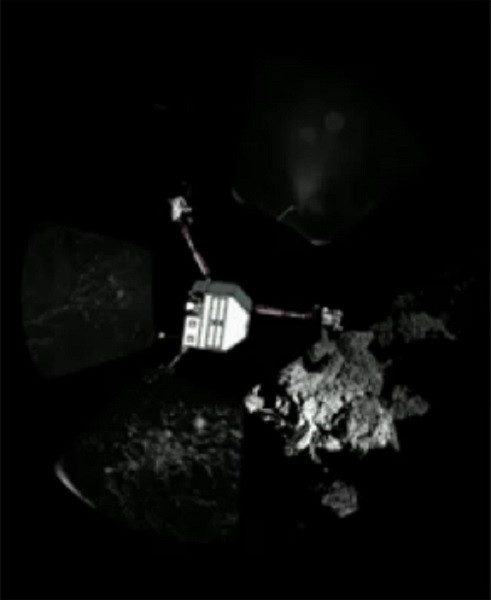Goodbye Philae: Chances of contacting Rosetta lander on Comet 67P 'close to zero'

The European Space Agency (ESA) has said it is time to say goodbye to Philae, the lander that made history in November 2014 as part of the Rosetta mission. It last made contact seven months ago, and scientists say the chances of contacting it again are "close to zero".
Philae landed on an area of Comet 67P/Churyumov–Gerasimenko that made it difficult to charge its solar-powered batteries. While it returned images and data – around 80% of its planned missions were completed – it has not contacted the Rosetta spacecraft since 9 July 2015.
"The chances for Philae to contact our team at our lander control centre are unfortunately getting close to zero," says Stephan Ulamec, Philae's project manager. "We are not sending commands any more and it would be very surprising if we were to receive a signal again."
The ESA said Philae is facing conditions on the comet "from which it is unlikely to recover". Teams of engineers and scientists have been carrying out extensive investigations to better understand the status of the lander, with results indicating there is little hope of establishing contact again.
When Philae landed on the surface of the comet a faulty thruster and a harpoon failure meant it did not lock itself onto the surface immediately. Instead it bounced from its initial touchdown point to a different landing site, the exact location of which was unknown.
Still listening, but I fear @Philae2014 is facing tough conditions on #67P... Status report: https://t.co/4kfMlZeSnO pic.twitter.com/w3QfmpwrTa
— ESA Rosetta Mission (@ESA_Rosetta) February 12, 2016
"A reconstruction of the flight of the lander suggested that it made contact with the comet four times during its two-hour additional flight across the small comet lobe," ESA said. "After bouncing from Agilkia, it grazed the rim of the Hatmehit depression, bounced again, and then finally settled on the surface at Abydos."
Researchers believe it landed in an awkward position on a cliff face, meaning it was shaded from the sun and unable to charge its batteries. It went into hibernation three days after landing. It woke up from this hibernation in June 2015, but the period of wakefulness proved short lived.
"On 13 June 2015, the lander finally hailed the orbiting Rosetta and subsequently transmitted housekeeping telemetry, including information from its thermal, power and computer subsystems.
"Subsequent analysis of the data indicated that the lander had in fact already woken up on 26 April 2015, but had been unable to send any signals until 13 June," a statement read.

"After 13 June, Philae made a further seven intermittent contacts with Rosetta in the following weeks, with the last coming on 9 July. However, the communications links that were established were too short and unstable to enable any scientific measurements to be commanded. Despite the improved thermal conditions, with temperatures inside Philae reaching 0C, no further contacts were made as the comet approached perihelion in August."
Engineers believe Philae's transmitters and receivers have likely failed, and that the lander may have dust covering its solar panels. Rosetta will continue to listen out for signals from the lander, but the chance of it sending anything is unlikely.
"We would be very surprised to hear from Philae again after so long, but we will keep Rosetta's listening channel on until it is no longer possible due to power constraints as we move ever further from the Sun towards the end of the mission," said Patrick Martin, ESA's Rosetta mission manager.
"Philae has been a tremendous challenge and for the lander teams to have achieved the science results that they have in the unexpected and difficult circumstances is something we can all be proud of. The combined achievements of Rosetta and Philae, rendezvousing with and landing on a comet, are historic high points in space exploration."
© Copyright IBTimes 2025. All rights reserved.






















